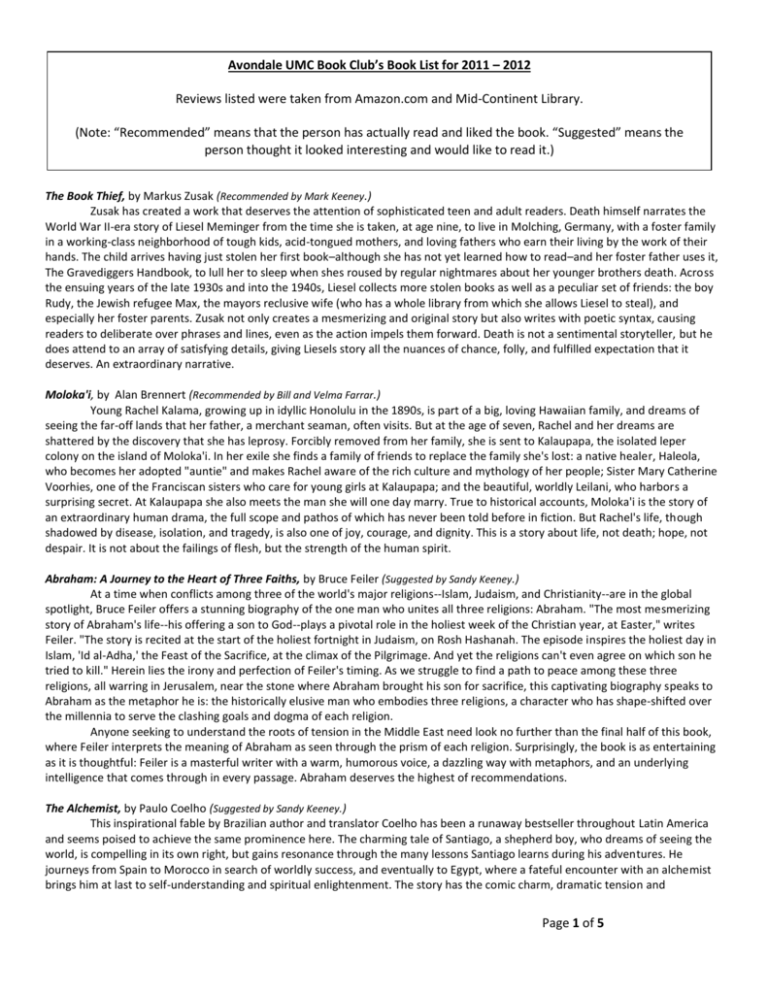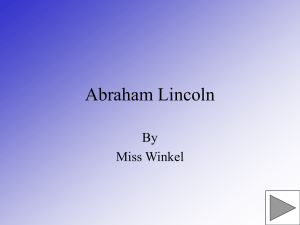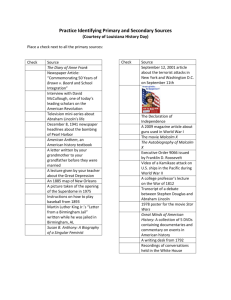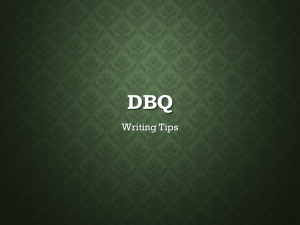The Book Thief, by Markus Zusak (Recommended by Mark Keeney
advertisement

Avondale UMC Book Club’s Book List for 2011 – 2012 Reviews listed were taken from Amazon.com and Mid-Continent Library. (Note: “Recommended” means that the person has actually read and liked the book. “Suggested” means the person thought it looked interesting and would like to read it.) The Book Thief, by Markus Zusak (Recommended by Mark Keeney.) Zusak has created a work that deserves the attention of sophisticated teen and adult readers. Death himself narrates the World War II-era story of Liesel Meminger from the time she is taken, at age nine, to live in Molching, Germany, with a foster family in a working-class neighborhood of tough kids, acid-tongued mothers, and loving fathers who earn their living by the work of their hands. The child arrives having just stolen her first book–although she has not yet learned how to read–and her foster father uses it, The Gravediggers Handbook, to lull her to sleep when shes roused by regular nightmares about her younger brothers death. Across the ensuing years of the late 1930s and into the 1940s, Liesel collects more stolen books as well as a peculiar set of friends: the boy Rudy, the Jewish refugee Max, the mayors reclusive wife (who has a whole library from which she allows Liesel to steal), and especially her foster parents. Zusak not only creates a mesmerizing and original story but also writes with poetic syntax, causing readers to deliberate over phrases and lines, even as the action impels them forward. Death is not a sentimental storyteller, but he does attend to an array of satisfying details, giving Liesels story all the nuances of chance, folly, and fulfilled expectation that it deserves. An extraordinary narrative. Moloka'i, by Alan Brennert (Recommended by Bill and Velma Farrar.) Young Rachel Kalama, growing up in idyllic Honolulu in the 1890s, is part of a big, loving Hawaiian family, and dreams of seeing the far-off lands that her father, a merchant seaman, often visits. But at the age of seven, Rachel and her dreams are shattered by the discovery that she has leprosy. Forcibly removed from her family, she is sent to Kalaupapa, the isolated leper colony on the island of Moloka'i. In her exile she finds a family of friends to replace the family she's lost: a native healer, Haleola, who becomes her adopted "auntie" and makes Rachel aware of the rich culture and mythology of her people; Sister Mary Catherine Voorhies, one of the Franciscan sisters who care for young girls at Kalaupapa; and the beautiful, worldly Leilani, who harbors a surprising secret. At Kalaupapa she also meets the man she will one day marry. True to historical accounts, Moloka'i is the story of an extraordinary human drama, the full scope and pathos of which has never been told before in fiction. But Rachel's life, though shadowed by disease, isolation, and tragedy, is also one of joy, courage, and dignity. This is a story about life, not death; hope, not despair. It is not about the failings of flesh, but the strength of the human spirit. Abraham: A Journey to the Heart of Three Faiths, by Bruce Feiler (Suggested by Sandy Keeney.) At a time when conflicts among three of the world's major religions--Islam, Judaism, and Christianity--are in the global spotlight, Bruce Feiler offers a stunning biography of the one man who unites all three religions: Abraham. "The most mesmerizing story of Abraham's life--his offering a son to God--plays a pivotal role in the holiest week of the Christian year, at Easter," writes Feiler. "The story is recited at the start of the holiest fortnight in Judaism, on Rosh Hashanah. The episode inspires the holiest day in Islam, 'Id al-Adha,' the Feast of the Sacrifice, at the climax of the Pilgrimage. And yet the religions can't even agree on which son he tried to kill." Herein lies the irony and perfection of Feiler's timing. As we struggle to find a path to peace among these three religions, all warring in Jerusalem, near the stone where Abraham brought his son for sacrifice, this captivating biography speaks to Abraham as the metaphor he is: the historically elusive man who embodies three religions, a character who has shape-shifted over the millennia to serve the clashing goals and dogma of each religion. Anyone seeking to understand the roots of tension in the Middle East need look no further than the final half of this book, where Feiler interprets the meaning of Abraham as seen through the prism of each religion. Surprisingly, the book is as entertaining as it is thoughtful: Feiler is a masterful writer with a warm, humorous voice, a dazzling way with metaphors, and an underlying intelligence that comes through in every passage. Abraham deserves the highest of recommendations. The Alchemist, by Paulo Coelho (Suggested by Sandy Keeney.) This inspirational fable by Brazilian author and translator Coelho has been a runaway bestseller throughout Latin America and seems poised to achieve the same prominence here. The charming tale of Santiago, a shepherd boy, who dreams of seeing the world, is compelling in its own right, but gains resonance through the many lessons Santiago learns during his adventures. He journeys from Spain to Morocco in search of worldly success, and eventually to Egypt, where a fateful encounter with an alchemist brings him at last to self-understanding and spiritual enlightenment. The story has the comic charm, dramatic tension and Page 1 of 5 psychological intensity of a fairy tale, but it's full of specific wisdom as well, about becoming self-empowered, overcoming depression, and believing in dreams. The cumulative effect is like hearing a wonderful bedtime story from an inspirational psychiatrist. Comparisons to The Little Prince are appropriate; this is a sweetly exotic tale for young and old alike. The Help, by Kathryn Stockett (Recommended by Nancy Mehl, “One of my top ten favorite books.”) What perfect timing for this optimistic, uplifting debut novel set during the nascent civil rights movement in Jackson, Miss., where black women were trusted to raise white children but not to polish the household silver. Eugenia Skeeter Phelan is just home from college in 1962, and, anxious to become a writer, is advised to hone her chops by writing about what disturbs you. The budding social activist begins to collect the stories of the black women on whom the country club sets relies and mistrusts enlisting the help of Aibileen, a maid who's raised 17 children, and Aibileen's best friend Minny, who's found herself unemployed more than a few times after mouthing off to her white employers. The book Skeeter puts together based on their stories is scathing and shocking, bringing pride and hope to the black community, while giving Skeeter the courage to break down her personal boundaries and pursue her dreams. Assured and layered, full of heart and history, this one has bestseller written all over it. Their Eyes Were Watching God, by Zora Neale Hurston (Recommended by Nancy Mehl.) At the height of the Harlem Renaissance during the 1930s, Zora Neale Hurston was the preeminent black woman writer in the United States. She was a sometime-collaborator with Langston Hughes and a fierce rival of Richard Wright. Her stories appeared in major magazines, she consulted on Hollywood screenplays, and she penned four novels, an autobiography, countless essays, and two books on black mythology. Yet by the late 1950s, Hurston was living in obscurity, working as a maid in a Florida hotel. She died in 1960 in a Welfare home, was buried in an unmarked grave, and quickly faded from literary consciousness until 1975 when Alice Walker almost single-handedly revived interest in her work. Of Hurston's fiction, Their Eyes Were Watching God is arguably the best-known and perhaps the most controversial. The novel follows the fortunes of Janie Crawford, a woman living in the black town of Eaton, Florida. Hurston sets up her characters and her locale in the first chapter, which, along with the last, acts as a framing device for the story of Janie's life. Unlike Wright and Ralph Ellison, Hurston does not write explicitly about black people in the context of a white world--a fact that earned her scathing criticism from the social realists--but she doesn't ignore the impact of black-white relations either. One person the citizens of Eaton are inclined to judge is Janie Crawford, who has married three men and been tried for the murder of one of them. Janie feels no compulsion to justify herself to the town, but she does explain herself to her friend, Phoeby, with the implicit understanding that Phoeby can "tell 'em what Ah say if you wants to. Dat's just de same as me 'cause mah tongue is in mah friend's mouf." Hurston's use of dialect enraged other African American writers such as Wright, who accused her of pandering to white readers by giving them the black stereotypes they expected. Decades later, however, outrage has been replaced by admiration for her depictions of black life, and especially the lives of black women. In Their Eyes Were Watching God Zora Neale Hurston breathes humanity into both her men and women, and allows them to speak in their own voices. Angels and Demons, by Dan Brown (Recommended by Rebecca Bennett.) Angels & Demons is a no-holds-barred, pull-out-all-the-stops, breathless tangle of a thriller--think Katherine Neville's The Eight (but cleverer) or Umberto Eco's Foucault's Pendulum (but more accessible). Harvard symbologist Robert Langdon is shocked to find proof that the legendary secret society, the Illuminati--dedicated since the time of Galileo to promoting the interests of science and condemning the blind faith of Catholicism--is alive, well, and murderously active. Brilliant physicist Leonardo Vetra has been murdered, his eyes plucked out, and the society's ancient symbol branded upon his chest. His final discovery, antimatter, the most powerful and dangerous energy source known to man, has disappeared--only to be hidden somewhere beneath Vatican City on the eve of the election of a new pope. Langdon and Vittoria, Vetra's daughter and colleague, embark on a frantic hunt through the streets, churches, and catacombs of Rome, following a 400year-old trail to the lair of the Illuminati, to prevent the incineration of civilization. Brown seems as much juggler as author--there are lots and lots of balls in the air in this novel, yet Brown manages to hurl the reader headlong into an almost surreal suspension of disbelief. While the reader might wish for a little more sardonic humor from Langdon, and a little less bombastic philosophizing on the eternal conflict between religion and science, these are less fatal flaws than niggling annoyances--readers should have no trouble skimming past them and immersing themselves in a heck of a good read. "Brain candy" it may be, but my! It's tasty. Page 2 of 5 Nemesis, by Philip Roth. The fourth in the great and undiminished Roth’s recent cycle of short novels follows Everyman (2006), Indignation (2008), and The Humbug (2009), and as exceptional as those novels are, this latest in the series far exceeds its predecessors in both emotion and intellect. In general terms, the novel is a staggering visit to a time and place when a monumental health crisis dominated the way people led their day-to-day lives. Newark, New Jersey, in the early 1940s (a common setting for this author) experienced, as the war in Europe was looking better for the Allies, a scare as deadly as warfare. The city has been hit by an epidemic of polio. Of course, at that time, how the disease spread and its cure were unknown. The city is in a panic, with residents so suspicious of other individuals and ethnic groups that emotions quickly escalate into hostility and even rage. Our hero, and he proves truly heroic, is Bucky Canter, playground director in the Jewish neighborhood of Newark. As the summer progresses, Bucky sees more and more of his teenage charges succumb to the disease. When an opportunity presents itself to leave the city for work in a Catskills summer camp, Bucky is torn between personal safety and personal duty. What happens is heartbreaking, but the joy of having met Bucky redeems any residual sadness. [The plots of the four novels in the “cycle” mentioned are unrelated to each other.] Running the Books: The Adventures of an Accidental Prison Librarian, by Ari Steinberg. When Steinberg graduated from Harvard, he expected to become a rabbi, but neither his faith nor his chosen lifestyle made that a suitable career choice. Seeking direction--and dental insurance--Steinberg takes a job as a librarian in a tough Boston prison. There he was responsible not only for the day-to-day functioning of the library but also for teaching inmates creative writing. A dedicated intellectual and instinctively diffident, he was almost too easy prey for tough, aggressive, streetwise, ever-conniving criminals. To his chagrin, the hard-bitten prison staff equally tested his presuppositions about humanity's benevolence. Caroming instantaneously from profane comedy to abysmal tragedy, Steinberg recounts his struggles to relate humanely to people at the edge of society. Prison librarianship offers some of the profession's greatest challenges, and Steinberg tells just what it's like to suddenly recognize that the mugger attacking him in the park was the same guy he had checked out some books to a few months earlier. The Immortal Life of Henrietta Lacks, by Rebecca Skloot. Recommended by Nancy Mehl. Science journalist Skloot makes a remarkable debut with this multilayered story about "faith, science, journalism, and grace." It is also a tale of medical wonders and medical arrogance, racism, poverty and the bond that grows, sometimes painfully, between two very different women-Skloot and Deborah Lacks-sharing an obsession to learn about Deborah's mother, Henrietta, and her magical, immortal cells. Henrietta Lacks was a 31-year-old black mother of five in Baltimore when she died of cervical cancer in 1951. Without her knowledge, doctors treating her at Johns Hopkins took tissue samples from her cervix for research. They spawned the first viable, indeed miraculously productive, cell line-known as HeLa. These cells have aided in medical discoveries from the polio vaccine to AIDS treatments. What Skloot so poignantly portrays is the devastating impact Henrietta's death and the eventual importance of her cells had on her husband and children. Skloot's portraits of Deborah, her father and brothers are so vibrant and immediate they recall Adrian Nicole LeBlanc's Random Family. Writing in plain, clear prose, Skloot avoids melodrama and makes no judgments. Letting people and events speak for themselves, Skloot tells a rich, resonant tale of modern science, the wonders it can perform and how easily it can exploit society's most vulnerable people. The Imperfectionists, by Tom Rachman. Set against the gorgeous backdrop of Rome, Tom Rachman's wry, vibrant debut follows the topsy-turvy private lives of the reporters, editors, and executives of an international English language newspaper as they struggle to keep it - and themselves-afloat. Fifty years and many changes have ensued since the paper was founded by an enigmatic millionaire, and now, amid the stained carpeting and dingy office furniture, the staff's personal dramas seem far more important than the daily headlines. Kathleen, the imperious editor in chief, is smarting from a betrayal in her open marriage; Arthur, the lazy obituary writer, is transformed by a personal tragedy; Abby, the embattled financial officer, discovers that her job cuts and her love life are intertwined in a most unexpected way. Out in the field, a veteran Paris freelancer goes to desperate lengths for his next byline, while the new Cairo stringer is mercilessly manipulated by an outrageous war correspondent with an outsize ego. And in the shadows is the isolated young publisher who pays more attention to his prized basset hound, Schopenhauer, than to the fate of his family's quirky newspaper. As the era of print news gives way to the Internet age and this imperfect crew stumbles toward an uncertain future, the paper's rich history is revealed, including the surprising truth about its founder's intentions. Spirited, moving, and highly original, The Imperfectionists will establish Tom Rachman as one of our most perceptive, assured literary talents. The Screwtape Letters, with Screwtape Proposes a Toast, by C. S. Lewis. Recommended by Mark Whitaker. Page 3 of 5 In this humorous and perceptive exchange between two devils, C. S. Lewis delves into moral questions about good vs. evil, temptation, repentance, and grace. Through this wonderful tale, the reader emerges with a better understanding of what it means to live a faithful life. Lewis's satire is a Christian classic. Screwtape is a veteran demon in the service of "Our Father Below" whose letters to his nephew and protege, Wormwood, instruct the demon-in-training in the fine points of leading a new Christian astray. Lewis's take on human nature is as on-target as it was when the letters were first published in 1941. Bloody Crimes: The Chase for Jefferson Davis and the Death Pageant for Lincoln's Corpse, by James L. Swanson. Suggested by Sandy Keeney. It's April 1865 and General Lee's troops have officially surrendered. Abraham Lincoln, looking forward to rebuilding the nation, celebrates with an evening—his last alive—at the theater. On the other side of the Mason-Dixon Line Jefferson Davis plans to move the Confederate government to North Carolina, away from Union troops that have captured Richmond. Under much different circumstances, both men embark on a dramatic final journey depicted by James. L. Swanson in Bloody Crimes, a gripping account of the weeks following Lincoln’s death and the end of the Civil War. While arguments erupted about where and how Lincoln’s burial should take place, Jefferson Davis—refusing to let the South succumb—attempted to rally his people despite being hunted by Northern troops who suspected his involvement in Lincoln’s assassination. Using relics and key documents of the day, Swanson juxtaposes the travels of Davis and Lincoln, weaving a fast-paced narrative that lures readers in from the get-go. We know that eventually Lincoln makes it to his final resting place and Davis is captured, but along the way it’s hard not to wonder if these two heroic leaders were more similar than perhaps anyone would have guessed. Whether read as a companion to Manhunt—Swanson’s account of the 12-day search for John Wilkes Booth—or on its own, Bloody Crimes is the next great Civil War-era read worthy of the recognition that Lincoln once said we should all strive for. (Amazon.com Best Books of the Month, Oct. 2010) The Life and Times of the Thunderbolt Kid: A Memoir, by Bill Bryson. Recommended by The Happy Bookers (Nancy Mehl’s “other” book club.) The Thunderbolt Kid was "born" in the 1950s when six-year-old Bryson found a mysterious, scratchy green sweater with a satiny thunderbolt across the chest. The jersey bestowed magic powers on the wearer-X-ray vision and the power to zap teachers and babysitters and deflect unwanted kisses from old people. These are the memoirs of that Kid, whose earthly parents were not really half bad-a loving mother who didn't cook and was pathologically forgetful, but shared her love of movies with her youngest child, and a dad who was the "greatest baseball writer that ever lived" and took his son to dugouts and into clubhouses where he met such famous players as Stan Musial and Willie Mays. Simpler times are conveyed with exaggerated humor; the author recalls the middle of the last century in the middle of the country (Des Moines, IA), when cigarettes were good for you, waxy candies were considered delicious, and kids were taught to read with Dick and Jane. Students of the decade's popular culture will marvel at the insular innocence described, even as the world moved toward nuclear weapons and civil unrest. Bryson describes country fairs and fantastic ploys to maneuver into the tent to see the lady stripper, playing hookey, paper routes, church suppers, and more. His reminiscences will entertain a wide audience. Follow the River, by James Thom. Recommended by The Happy Bookers. Mary Ingles was twenty-three, married, and pregnant, when Shawnee Indians invaded her peaceful Virginia settlement, killed the men and women, then took her captive. For months, she lived with them, unbroken, until she escaped, and followed a thousand mile trail to freedom--an extraordinary story of a pioneer woman who risked her life to return to her people. The Art of Racing in the Rain, by Garth Stein. Copies available at Mid-Continent Library. On the eve of his death, Enzo takes stock of his life, recalling all that he and his family have been through. He is different from other dogs: a philosopher with a nearly human soul (and an obsession with opposable thumbs), he has educated himself by watching television extensively, and by listening very closely to the words of his master, Denny Swift, an up-and-coming race car driver. A heart-wrenching but deeply funny and ultimately uplifting story of family, love, loyalty, and hope, The Art of Racing in the Rain is a beautifully crafted and captivating look at the wonders and absurdities of human life . . . as only a dog could tell it. The Elephant's Journey, by Jose Saramago (Suggested by Sandy Keeney.) In 1551, King João III of Portugal gave Archduke Maximilian an unusual wedding present: an elephant named Solomon. The elephant’s journey from Lisbon to Vienna was witnessed and remarked upon by scholars, historians, and ordinary people. Out of this material, José Saramago has spun a novel already heralded as “a triumph of language, imagination, and humor” (El País). Solomon and his keeper, Subhro, begin in dismal conditions, forgotten in a corner of the palace grounds. When it occurs to the king and queen that an elephant would be an appropriate wedding gift, everyone rushes to get them ready: Subhro is given two new suits of clothes and Solomon a long overdue scrub. Page 4 of 5 Accompanied by the Archduke, his new wife, and the royal guard, our unlikely heroes traverse a continent riven by the Reformation and civil wars. They make their way through the storied cities of northern Italy: Genoa, Piacenza, Mantua, Verona, Venice, and Trento, where the Council of Trent is in session. They brave the Alps and the terrifying Isarco and Brenner Passes; they sail across the Mediterranean Sea and up the Inn River (elephants, it turns out, are natural sailors). At last they make their grand entry into the imperial city. The Elephant’s Journey is a delightful, witty tale of friendship and adventure. The Autobiography of Santa Claus, by Jeff Guinn. Recommended by Jonathan Lightfoot. Santa's autobiography combines solid historical fact with glorious legend to deliver the definitive story of Santa Claus. Families will delight in each chapter of this Christmas classic--one per each cold December night leading up to Christmas! Page 5 of 5








